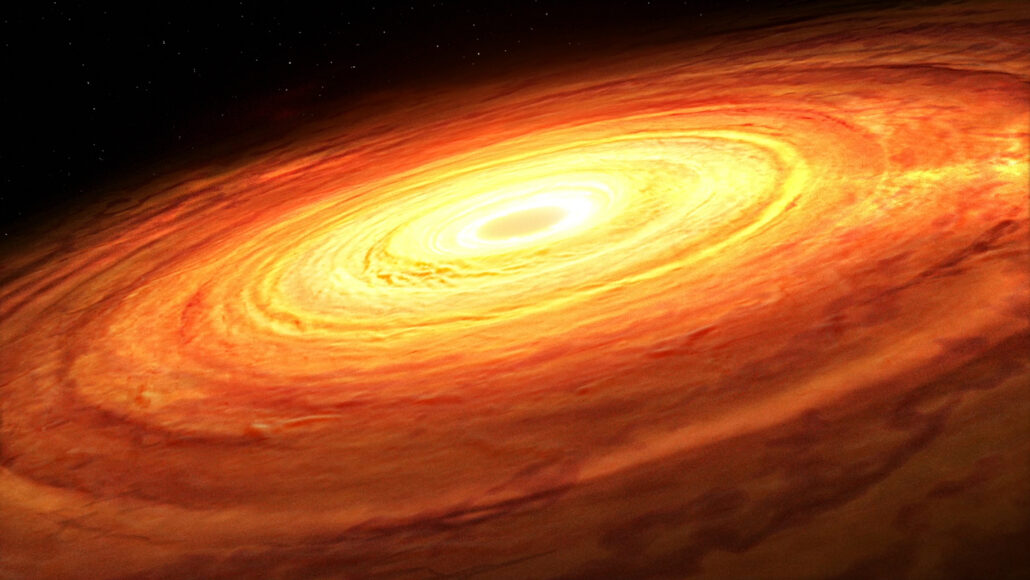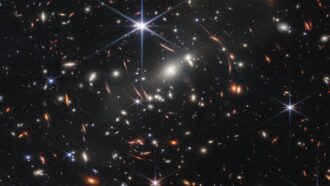Here’s an easier new way to weigh a black hole
Hints to its mass come from a flickering in the gas and dust in its accretion disk

Astronomers have figured out how to use the disk of hot gas and dust around some black holes (like the one shown in this artist’s illustration) to measure a black hole’s mass.
Mark A. Garlick, Simons Foundation
Black holes grow by feeding on material their intense gravitational fields pull toward them. That incoming meal collects into a disk of hot gas and dust — one that flickers like a campfire. Astronomers have now found that monitoring changes in those flickers can reveal something that has proven very hard to measure: the behemoth’s heft.
“It’s a new way to weigh black holes,” says Colin Burke. He’s an astronomer at the University of Illinois at Urbana-Champaign. This method could be used to measure any celestial object with an accretion disk, his team says. It may even help turn up long-sought midsize black holes. Burke’s team described its new technique August 13 in Science.
It’s not easy to measure a black hole’s mass. To start, these dark giants are truly hard to see. But sometimes a black hole will reveal itself as it dines. As gas and dust falls into it, that material organizes into a disk. Along the way, that material will heat to white-hot temperatures. In some cases, this disk can outshine all the stars combined that reside in the black hole’s host galaxy.
There’s another way to measure a black hole. Its diameter can reveal its mass using Einstein’s general theory of relativity. But only the globe-spanning Event Horizon Telescope has made been able to make this sort of measurement. And so far, it’s done it for only one black hole. Other black holes have been weighed via observations of their influence on the material around them. But that takes a lot of data and doesn’t work for every supermassive black hole.
Hoping to find another way, Burke’s team turned to accretion disks.

Educators and Parents, Sign Up for The Cheat Sheet
Weekly updates to help you use Science News Explores in the learning environment
Thank you for signing up!
There was a problem signing you up.
Those mysterious flickers
Astronomers aren’t sure why the disks of black holes flicker. It seems like small changes in light combine to brighten or dim the whole disk over a span of time. Previous research had hinted that the time it takes a disk to fade, brighten and fade again is related to the mass of its hungry black hole. But those claims were controversial. They also didn’t cover the full range of black hole masses, Burke says.
So he and some colleagues assembled observations of 67 actively feeding black holes. The mass of each was already known. Their masses spanned from 10,000 to 10 billion times that of our sun. For the smallest of these black holes, the flickers changed on timescales of hours to weeks. Supermassive black holes, having masses between 100 million and 10 billion times that of the sun flickered more slowly. The time for each flicker might last a few hundred days.
That was the hint, says Burke. If this relation holds for the full range of supermassive black holes, he says — from small to big ones — then “maybe it’s sort of a universal feature.”
Out of curiosity, his team also looked at white dwarfs. These are compact corpses of stars that may have started out the size of the sun. Now they’re far smaller — among the smallest objects to consistently host accretion disks. And, Burke’s team found, white-dwarf disks follow the same newfound relationship between flicker speed and mass.
The black holes that the researchers studied didn’t cover the entire possible range of masses. Few black holes have been identified with masses between 100 and 100,000 times that of the sun. There are several potential candidates in that range. To date, only one has been confirmed. In the future, this link between disk flickers and black-hole mass might tell astronomers exactly what rate of disk flickers to scout for when hunting midsize beasts — if they even exist, Burke says.
Vivienne Baldassare is an astrophysicist who works at Washington State University in Pullman. She studies black holes in dwarf galaxies. These galaxies may preserve some of the properties of ancient black holes that formed in the early universe. One of her biggest challenges, she’s found, is measuring black-hole masses. The new study’s “super exciting results … will have a large impact for my research, and I expect many others as well,” she says.
The flicker method is simpler than any previous technique to weigh black holes, Burke says. But, he cautions, it’s not necessarily a faster one. More massive black holes, for example, would need hundreds of days of observations, or possibly years, to tease out the flicker rates that might reveal their masses.
Upcoming observatories are, however, already planning to collect such data. The Vera C. Rubin Observatory is expected to start observing the entire sky every night within a year or two. Once it has been running long enough, the data needed to weigh black holes “will fall out for free,” Burke says. “We’re already building [that observatory]. We may as well do this.”







